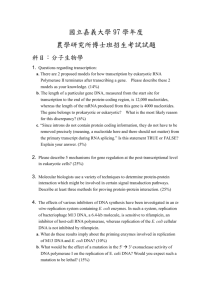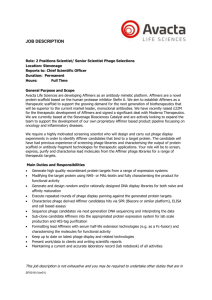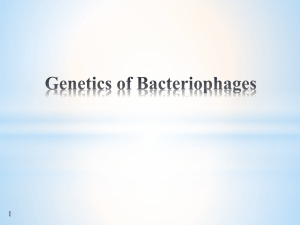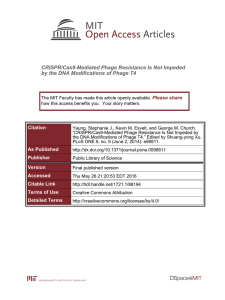Lytic Phage and Transduction
advertisement
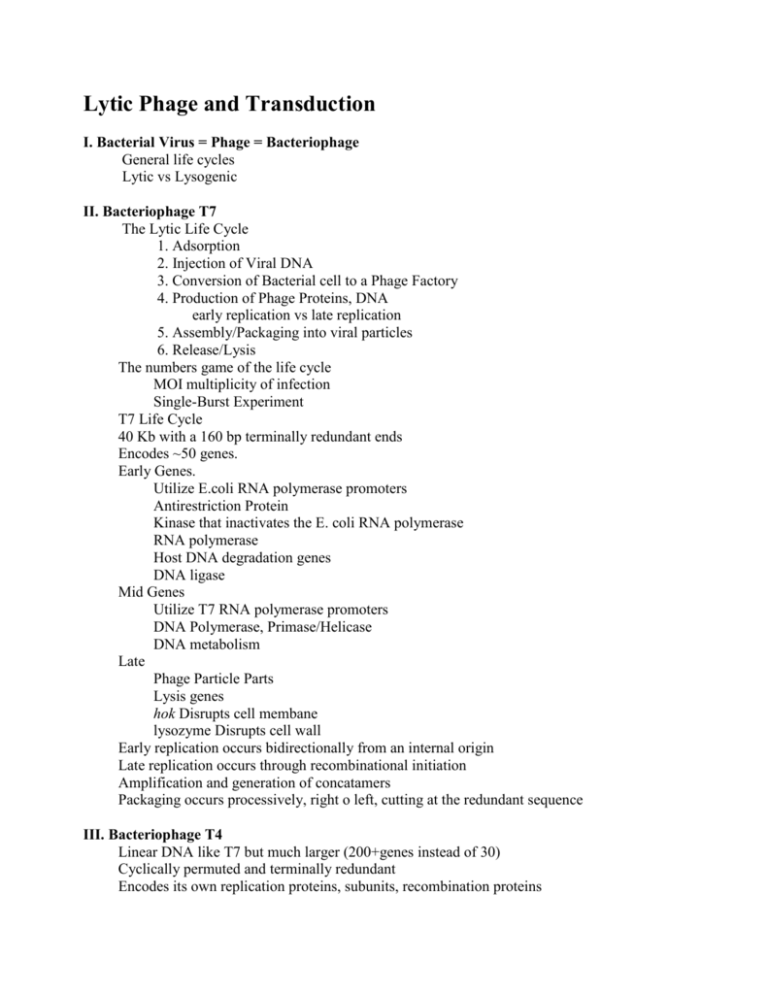
Lytic Phage and Transduction I. Bacterial Virus = Phage = Bacteriophage General life cycles Lytic vs Lysogenic II. Bacteriophage T7 The Lytic Life Cycle 1. Adsorption 2. Injection of Viral DNA 3. Conversion of Bacterial cell to a Phage Factory 4. Production of Phage Proteins, DNA early replication vs late replication 5. Assembly/Packaging into viral particles 6. Release/Lysis The numbers game of the life cycle MOI multiplicity of infection Single-Burst Experiment T7 Life Cycle 40 Kb with a 160 bp terminally redundant ends Encodes ~50 genes. Early Genes. Utilize E.coli RNA polymerase promoters Antirestriction Protein Kinase that inactivates the E. coli RNA polymerase RNA polymerase Host DNA degradation genes DNA ligase Mid Genes Utilize T7 RNA polymerase promoters DNA Polymerase, Primase/Helicase DNA metabolism Late Phage Particle Parts Lysis genes hok Disrupts cell membane lysozyme Disrupts cell wall Early replication occurs bidirectionally from an internal origin Late replication occurs through recombinational initiation Amplification and generation of concatamers Packaging occurs processively, right o left, cutting at the redundant sequence III. Bacteriophage T4 Linear DNA like T7 but much larger (200+genes instead of 30) Cyclically permuted and terminally redundant Encodes its own replication proteins, subunits, recombination proteins Instead of its own RNA polymerase, alters the specificity of the bacterial polyerase gp55 sigma factor (recognizes TATAAATA at -10 position) Transcription is coupled to replication gp45 (sliding clamp of the replication polymerase) also acts as a transcriptional activator Biphasic Replication Early origin dependant replication Late recombination dependant amplification Highly recombinagenic Phage packaging occurs by headful mechanism (stuff the head until its full) IV. Transduction general transduction P1 phage of Escherichia coli P22 phage of Samonella enterica What makes a good transducing phage? specialized transduction phage lambda Mapping by Transduction Fixed distance/ short range mapping As a tool for gene knockouts Transduction in Evolution V. The rII gene and its insights Used for recombinational studies Recombination frequency=#recombinant progeny/total progeny 1 Map unit= 1% recombination frequency Used for complementation Can mutant phage make wild type progeny when coinfected? rII- rapid lysis mutants type II form hard clear plaques on E.coli instead of normal fuzzy edged plaques rII mutants cannot grow in E.coli carrying phage lamda lysogens rII mutants can grow in normal E.coli wild type T4 (r+) can grow in E.coli carrying phage lamda lysogens Seymour Benzer 1950s mutants of rII (Watson/Crick DNA structure 1953) (Messelson/Stahl Semiconservative replication 1958) Complementation studies of rII mutants Showed that all mutations fell within two genes rIIA rIIB Recombination frequencies: How to score for recombinants Intragenic supressors: Genes were not discreet units but divisable Mutational Spectra: Hot Spots for each mutagen Francis Crick Helped ID the structure of DNA and knew it was the genetic information but... How was the genetic information read? Trivia that he used in his experiments 1.) acridine dyes induce frameshifts: (not leaky but can revert) 2.) N terminus of rIIB protein is nonessential (deletion mutants showed this) Genetic code is unpunctuated, a triplet, and redundant*** Isolate rIIB insertion mutation FC0, isolate rIIB supressors, isolate rIIB supressors of supressors...
